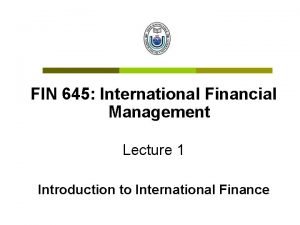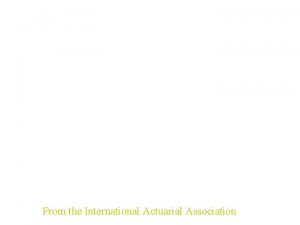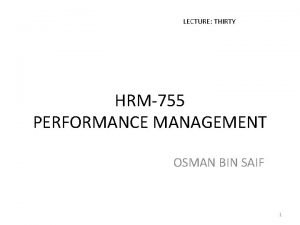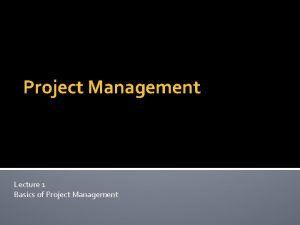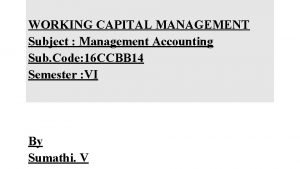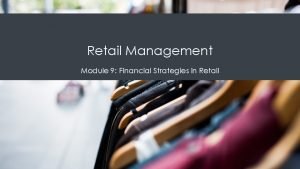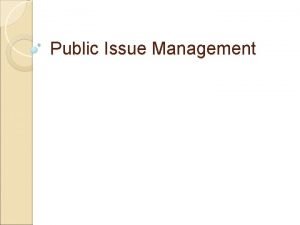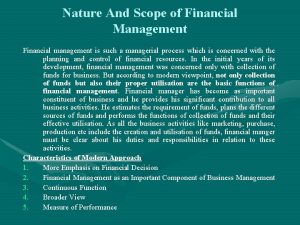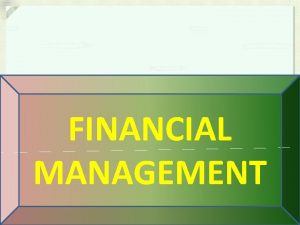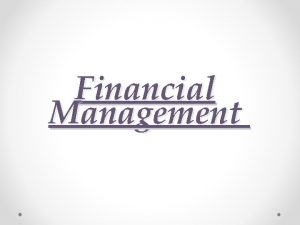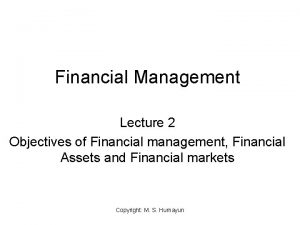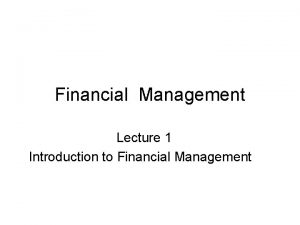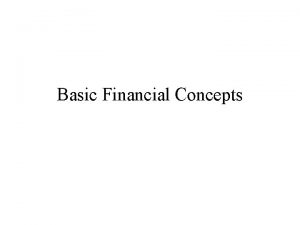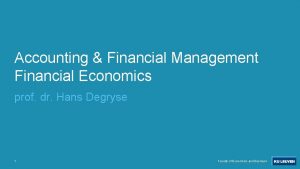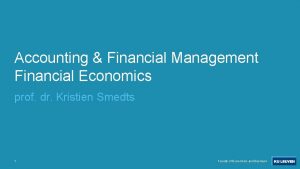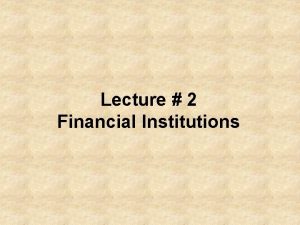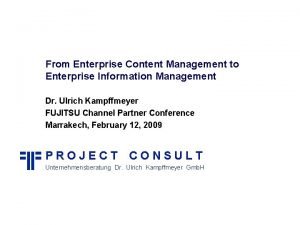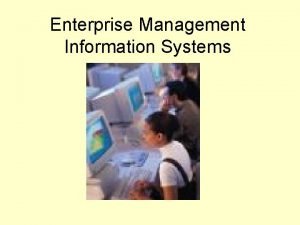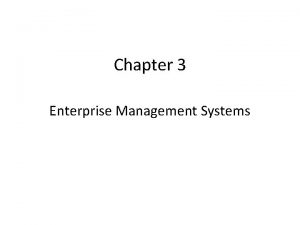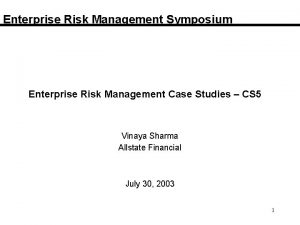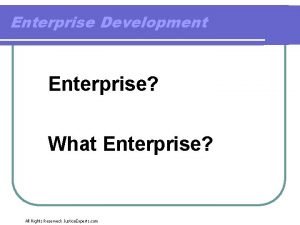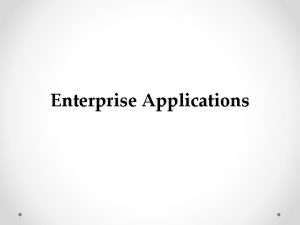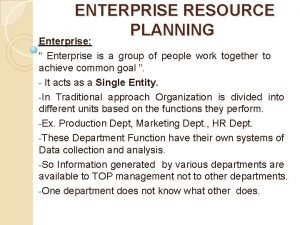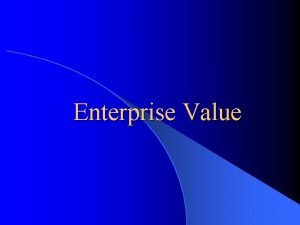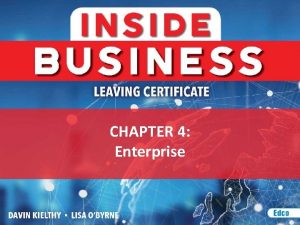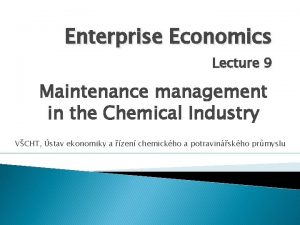Enterprise Economics Lecture 10 Enterprise Economics Management Financial








































- Slides: 40

Enterprise Economics Lecture 10 Enterprise Economics Management, Financial Analysis and Company Profitability VŠCHT, Ústav ekonomiky a řízení chemického a potravinářského průmyslu Erasmus 2016/2017

Enterprise Economics Management

Enterprise Economics Management Basic economic competences of Company management – CFO (Chief Financial Officer): - Treasury (Cash Management, Loans) - Accounting (Statutory Statements) - Reporting - Planning

Enterprise Economics Management � Financial - - management is mainly affected by two factors: The consequences of today’s decision on allocation of financial resources are going to be exhibited in the future. This is called time factor. Risk factor means that every available option is affected by circumstances, on which we, as investors, have no straight influence, and which can cause the profits to be lower than desired.

Financial Analysis

Financial Analysis Accounting reports, as we have already discussed in previous lessons, are the starting point for analytical activity. A mere comparison of absolute numbers does not allow to effectively use the accounting reports for a mutual comparison between more enterprises so ratio comparison is often used. � The goals of a financial analysis are: - to choose a suitable ratio indicators and to calculate their value - to compare the values of these indicators with sector values (comparative analysis) - to evaluate the ratio indicators in mutual relationships - to observe and evaluate the ratio indicators in time (trend analysis) �

Analysis of rentability � ROA (Return on Assets) � ROE (Return on Equity) � ROS (Return on Sales) ◦ EBIT / Assets ◦ Profit after tax/ Equity ◦ Profit after tax/ Sales

Analysis of activity � Turnover of Assets � Turnover of Inventory ◦ Assets / (Revenues / 365) ◦ Inventory / (Revenues / 365) � Time of collection of Receivables ◦ Receivables / (Revenues / 365)

Analysis of long-term financial stability � Equity Ratio ◦ Equity/ Assets � Debt Equity Ratio ◦ Liabilities/ Equity � Interest Coverage ◦ EBIT/ Interests

Analysis of payment ability � Current Liquidity ◦ Current Assets/ Short-term debts � Quick Liquidity ◦ (Short-term receivables + Financial assets) / Short-term debt � Cash Liquidity ◦ Financial Assets / Short-term debts

Measurement of the operating profitability

Structure of a profitability analysis – expanded Du Pont model Figure 1 Structure of profitability analysis – Du Pont model

Key financial ratios Return on invested capital (ROIC) Measures the profitability of the operations The return on invested capital disregards how a firm is financed Profit margin (PM) Measures a firm’s ability to generate profit after consideration of all operating expenses Turnover rate of invested capital (ATO) Measures a firm’s effectiveness in using its assets invested in the operation (invested capital).

Return on invested capital (ROIC)

Return on invested capital for Carlsberg Is Carlsberg’s ROIC satisfactory? Figure 2 Return on invested capital for Carlsberg

Interpreting the return on invested capital It is important to address the following issues: � The level of returns ◦ An estimation of the required rate of return (WACC) ◦ A comparison with competitors (benchmarking) � The ◦ ◦ development of returns over time Stable Increasing Decreasing Fluctuating.

The level of return Carlsberg: ROIC vs. WACC Figure 3 Return on invested capital versus WACC for Carlsberg

The level of return Carlsberg’s ROIC vs. Heineken’s ROIC Figure 4 Comparison of the return on invested capital for Carlsberg and Heineken

Interpreting the return on invested capital Alternative interpretations � Often, high and positive developments in the return on invested capital is viewed as positive, as it signals increasing value creation � However, there are circumstances with alternative interpretations. For example, ROIC is affected by: ◦ ◦ Differences in accounting policies The average of assets Differences in operating risks Products’ lifecycle.

Differences in performance (ROIC) may be due to differences in business risk Projected operating earnings in different industries based on European data

Differences in performance (ROIC) may be due to differences in business risk (Continued) Projected operating earnings in different industries based on European data (Continued)

Differences in performance (ROIC) may be due to differences in business risk (Continued) Projected operating earnings in different industries based on European data (Continued)

Differences in performance (ROIC) may be due to differences in firms’ lifecycles Figure 5 Return on invested capital at different stages of the product lifecycle

Decomposition of return on invested capital � ROIC does not explain whether profitability is driven by a better revenue and expense relation or an improved capital utilisation. It is necessary to decompose the ratio into (a) The profit margin (revenue/expense relation), PM (b) The turnover rate of invested capital (capital utilisation), ATO where ROIC = PM ATO

Decomposition of ROIC in operating margin and turnover rate (Continued) � Heavy investment companies, like pharmaceutical companies, are located in area ‘A’ ◦ Companies with a high proportion of fixed costs, and often low turnover rates ◦ To attract capital to the industry, it is necessary to generate higher profit margins to compensate for the low turnover rate ◦ The higher profit is achieved usually because of some special product properties that are difficult to imitate, or competitive advantages leading to a reduction in the intensity of competition in the industry. � Companies that offer standard services (commodities) often operate in area ‘B’ ◦ Companies are affected by significant competition ◦ Fierce competition lead an upper limit to the profit margin ◦ Price is typically the most important parameter, as the products or services do not differ significantly among competitors ◦ To attract capital for such undertakings, they need to generate high turnover rates. A high turnover rate is achieved by tight costs control throughout the value chain, while invested capital is held at a minimum.

The level of return – decomposition Comparison of profit margin of Heineken and Carlsberg Figure 6 Comparison of profit margin of Heineken and Carlsberg

The level of return – decomposition Comparison of turnover rate of Heineken and Carlsberg Figure 7 Comparison of turnover rate for Heineken and Carlsberg

The level of return Decomposition of profit margin and turnover rate � � � An analysis of the profit margin and turnover rate of capital helps to explain whether the revenue/expense relation and the capital utilisation efficiency have improved The analysis of the two ratios is, however, vague in their description of why the ratios have evolved as they have In order to deepen our understanding of the evolution of the profit margin and asset turnover, it is necessary to decompose the two ratios further. This can be done in two ways: Indexing (trend analysis) � Common-size analysis. �

Trend analysis – Carlsberg Trend analysis of Carlsberg’s revenue and operating expenses


Structure of a profitability analysis – expanded Du Pont model Market growth Revenue Production Profit Margin Marketing Market size Market share Price Distribution Administration Amortisation and depreciation ROIC Non-current assets Inventories Turnover rate Invested capital EVA Receivables Operating cash Operating liabilities Financial leverage WACC Creditors’ required rate of return Investors’ required rate of return The firm’s competitive edge Is it possible to decompose the financial ratios describing the operating profitability further… The information disclosed in the annual report does not typically allow for a more detailed analysis of the profitability at the following levels: • Location • Product (group) • Customer (group)

The impact of financing on profitability (return on equity)

Return on equity � ROIC measures operating profitability � Return on equity (ROE) measures the profitability taking into account returns earned on operations plus the effect of financial leverage:

Return on equity (Continued) ROE can be decomposed as follows: where ROIC BVE NIBD NBC = Return on invested capital after tax = Book value of equity = (Book value of) net interest bearing debt = Net borrowing cost after tax in percent

Investment effectiveness – dynamic methods

Investment effectiveness Net present value is calculated from discounted cash flow by adding a value C 0, which is the cash flow in the beginning. Because this value is most of the times an expense (purchase of new equipment, bank deposit, …) this value is negative. If NPV > 0 then we should invest; if NPV < 0 then we should not invest; if NPV=0 then the investment is marginal. If we think about the values in the formula, it is obvious that we only know the value C 0, which is the own expenditure on the investment. Future cash flows Ct are determined by a qualified guess. When determining them, it is important to bear in mind a few realities: - we should always consider real cash flows, not profits (see chapter 3. 2); - taxes should be discounted at the time they are actually paid, not when they are accounted for in the books as an obligation of the company to the state; - new production usually requires an increase in work capital and in resources supply, receivables usually increase, the stocks of finished products increase, and liabilities towards suppliers also increase; - new equipment generates depreciation, which creates a positive increase in cash flow; - a project can generate an increased need for overhead costs (salaries, rent for new offices, etc. ); - it is important to work with inflation.

Investment effectiveness Example 1: � A company decided to invest 1, 000 CZK into new equipment. It assumes that the incomes from products produced by this equipment will be gained over four years, and the incomes for individual years (after the deduction of necessary expenses) will be as follows: � Year 1: 200 000 � Year 2: 350 000 � Year 3: 380 000 � Year 4: 380 000 The company says that the alternative cost of capital is 7%. Should the company invest? To answer this question about the effectiveness of the investment we will calculate its NPV: Because the NPV is positive, the company should invest.

Investment effectiveness Example 2: � A company decided to invest 1, 000 CZK into new equipment. It assumes that the incomes from products produced by this equipment will be gained over four years. When checking the calculations, the incomes and corresponding expenses will be distributed differently over the four years. How is the effectiveness of the investment going to change? : � Year 1: 100 000 � Year 2: 300 000 � Year 3: 470 000 � Year 4: 440 000 The company says that the alternative cost of capital is 7%. Should the company invest? To answer this question about the effectiveness of the investment we will calculate its NPV: Because the NPV is positive, the company should invest.

Investment effectiveness Example 3: � A company decided to invest 1, 000 CZK into new equipment. It assumes that the incomes from products produced by this equipment will be gained over four years. Having the same incomes and corresponding expenses as Example 2 but raising the alternative cost of capital to 10% because of the riskiness of the project. How is the effectiveness of the investment going to change? : � Year 1: 100 000 � Year 2: 300 000 � Year 3: 470 000 � Year 4: 440 000 To answer this question about the effectiveness of the investment we will calculate its NPV: Because the NPV is negative, the company should not invest.

Conclusions � � � � Monitoring a firm’s profitability is a key issue in financial statement analysis A profitability analysis reveals important information about the trend and level of key ratios describing different aspects of a firm’s profitability A profitability analysis provides useful information in order to evaluate performance of management or develop assumptions about the future profitability of a firm – for instance, for valuation purposes Financial ratios, such as return on invested capital (ROIC), profit margin (PM)and turnover rate of invested capital (ATO), are used to assess the operating profitability Return on invested capital is the most important ratio, as it measures the return on net operating assets employed by a firm Financial ratios should be defined consistently across time and across firms Dynamic methods for Investment evaluation are most common tool for Investment decision making
 Financial management lecture
Financial management lecture 01:640:244 lecture notes - lecture 15: plat, idah, farad
01:640:244 lecture notes - lecture 15: plat, idah, farad Enterprise risk management for financial institutions
Enterprise risk management for financial institutions Financial engineering notes
Financial engineering notes Financial intermediaries ppt
Financial intermediaries ppt Principles of economics powerpoint lecture slides
Principles of economics powerpoint lecture slides Land use planning lecture notes
Land use planning lecture notes Health economics lecture notes
Health economics lecture notes Contemporary management ppt
Contemporary management ppt Non-financial methods of motivation
Non-financial methods of motivation Fefe curriculum
Fefe curriculum Family economics & financial education
Family economics & financial education Family economics and financial education
Family economics and financial education School of business and economics maastricht
School of business and economics maastricht Non mathematical economics
Non mathematical economics Project procurement management lecture notes
Project procurement management lecture notes Strategic management lecture
Strategic management lecture 4 p's of software project management
4 p's of software project management Project management lecture notes doc
Project management lecture notes doc Psa meaning in accounting
Psa meaning in accounting Operations management lecture notes doc
Operations management lecture notes doc Performance management lecture
Performance management lecture Human resources department structure
Human resources department structure Human resources introduction
Human resources introduction Human resource management lecture chapter 1
Human resource management lecture chapter 1 Project cost management lecture notes
Project cost management lecture notes Project management lecture
Project management lecture Uphcp
Uphcp Risk management lecture
Risk management lecture Project planning and management lecture notes ppt
Project planning and management lecture notes ppt Network management principles
Network management principles Putting the enterprise into the enterprise system
Putting the enterprise into the enterprise system Enterprise
Enterprise Pyramid levels of management
Pyramid levels of management Top management middle management first line management
Top management middle management first line management Basic concepts of management
Basic concepts of management Financial management subject code
Financial management subject code Retail financial management
Retail financial management Public issue management mean
Public issue management mean Nature of strategic financial management
Nature of strategic financial management Nature and scope financial management
Nature and scope financial management
